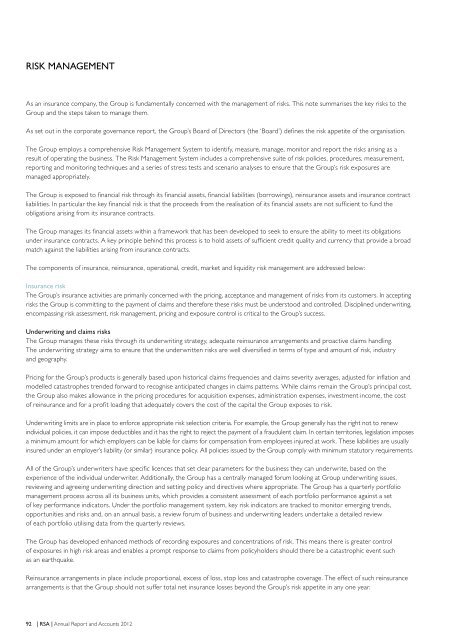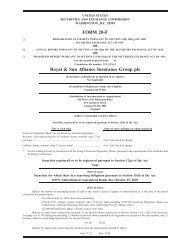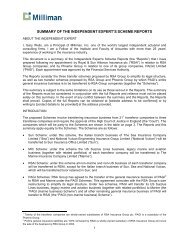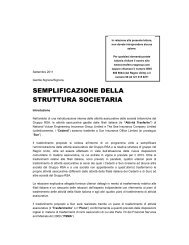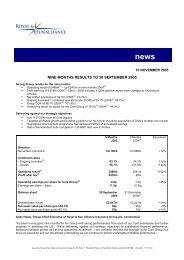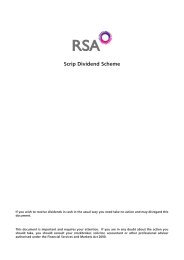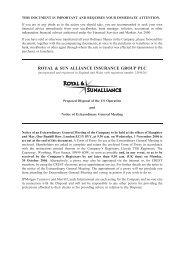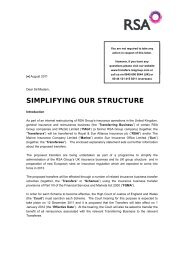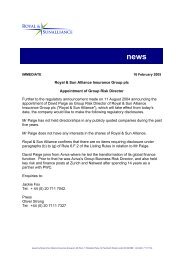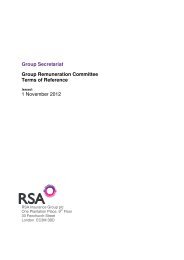ANNUAL REPORT AND ACCOUNTS 2012 - RSA, Annual Report ...
ANNUAL REPORT AND ACCOUNTS 2012 - RSA, Annual Report ...
ANNUAL REPORT AND ACCOUNTS 2012 - RSA, Annual Report ...
You also want an ePaper? Increase the reach of your titles
YUMPU automatically turns print PDFs into web optimized ePapers that Google loves.
RISK MANAGEMENT<br />
As an insurance company, the Group is fundamentally concerned with the management of risks. This note summarises the key risks to the<br />
Group and the steps taken to manage them.<br />
As set out in the corporate governance report, the Group’s Board of Directors (the ‘Board’) defines the risk appetite of the organisation.<br />
The Group employs a comprehensive Risk Management System to identify, measure, manage, monitor and report the risks arising as a<br />
result of operating the business. The Risk Management System includes a comprehensive suite of risk policies, procedures, measurement,<br />
reporting and monitoring techniques and a series of stress tests and scenario analyses to ensure that the Group’s risk exposures are<br />
managed appropriately.<br />
The Group is exposed to financial risk through its financial assets, financial liabilities (borrowings), reinsurance assets and insurance contract<br />
liabilities. In particular the key financial risk is that the proceeds from the realisation of its financial assets are not sufficient to fund the<br />
obligations arising from its insurance contracts.<br />
The Group manages its financial assets within a framework that has been developed to seek to ensure the ability to meet its obligations<br />
under insurance contracts. A key principle behind this process is to hold assets of sufficient credit quality and currency that provide a broad<br />
match against the liabilities arising from insurance contracts.<br />
The components of insurance, reinsurance, operational, credit, market and liquidity risk management are addressed below:<br />
Insurance risk<br />
The Group’s insurance activities are primarily concerned with the pricing, acceptance and management of risks from its customers. In accepting<br />
risks the Group is committing to the payment of claims and therefore these risks must be understood and controlled. Disciplined underwriting,<br />
encompassing risk assessment, risk management, pricing and exposure control is critical to the Group’s success.<br />
Underwriting and claims risks<br />
The Group manages these risks through its underwriting strategy, adequate reinsurance arrangements and proactive claims handling.<br />
The underwriting strategy aims to ensure that the underwritten risks are well diversified in terms of type and amount of risk, industry<br />
and geography.<br />
Pricing for the Group’s products is generally based upon historical claims frequencies and claims severity averages, adjusted for inflation and<br />
modelled catastrophes trended forward to recognise anticipated changes in claims patterns. While claims remain the Group’s principal cost,<br />
the Group also makes allowance in the pricing procedures for acquisition expenses, administration expenses, investment income, the cost<br />
of reinsurance and for a profit loading that adequately covers the cost of the capital the Group exposes to risk.<br />
Underwriting limits are in place to enforce appropriate risk selection criteria. For example, the Group generally has the right not to renew<br />
individual policies, it can impose deductibles and it has the right to reject the payment of a fraudulent claim. In certain territories, legislation imposes<br />
a minimum amount for which employers can be liable for claims for compensation from employees injured at work. These liabilities are usually<br />
insured under an employer’s liability (or similar) insurance policy. All policies issued by the Group comply with minimum statutory requirements.<br />
All of the Group’s underwriters have specific licences that set clear parameters for the business they can underwrite, based on the<br />
experience of the individual underwriter. Additionally, the Group has a centrally managed forum looking at Group underwriting issues,<br />
reviewing and agreeing underwriting direction and setting policy and directives where appropriate. The Group has a quarterly portfolio<br />
management process across all its business units, which provides a consistent assessment of each portfolio performance against a set<br />
of key performance indicators. Under the portfolio management system, key risk indicators are tracked to monitor emerging trends,<br />
opportunities and risks and, on an annual basis, a review forum of business and underwriting leaders undertake a detailed review<br />
of each portfolio utilising data from the quarterly reviews.<br />
The Group has developed enhanced methods of recording exposures and concentrations of risk. This means there is greater control<br />
of exposures in high risk areas and enables a prompt response to claims from policyholders should there be a catastrophic event such<br />
as an earthquake.<br />
Reinsurance arrangements in place include proportional, excess of loss, stop loss and catastrophe coverage. The effect of such reinsurance<br />
arrangements is that the Group should not suffer total net insurance losses beyond the Group’s risk appetite in any one year.<br />
92<br />
| <strong>RSA</strong> | <strong>Annual</strong> <strong>Report</strong> and Accounts <strong>2012</strong>


